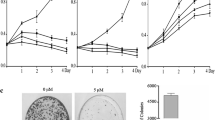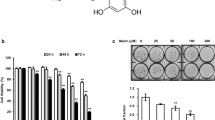Abstract
Objective
The aim of the study was to investigate the apoptosis induced by piperlongumine on human breast adenoma MDA-MB-231 cells and the mechanism involved.
Methods
Human breast adenoma MDA-MB-231 cells line was cultured in vitro. The inhibitory effect of piperlongumine on the proliferation of human breast adenoma MDA-MB-231 cells was measured by CCK-8 assay. Distribution of cell cycle was analyzed by flow cytometry. The apoptosis rates of MDA-MB-231 cells were measured using Annexin V/PI staining. The flow cytometry with the probe of DCFH-DA was used to detect the intracellular reactive oxygen species levels. Western blot was used to explore the protein expression of Bcl-2 and Bax.
Results
The CCK-8 assay showed that piperlongumine had an inhibiting effect on the proliferation of MDA-MB-231 cells in a concentration- and time-dependent manner. MDA-MB-231 cells were markedly arrested at G0/G1 phase after treatment of piperlongumine. Piperlongumine induced apoptosis of MDA-MB-231 cells obviously. The level of intracellular reactive oxygen species was increased in a dose-dependent manner. The antioxidant N-acetyl-L-cystein inhibited the apoptosis of cells and the level of intracellular reactive oxygen species was also decreased. By Western blot analysis, we found the expression of Bax was up-regulated whereas that of Bcl-2 was down-regulated in a concentration-dependent manner.
Conclusion
Piperlongumine possesses a significant function for inhibiting proliferation, arresting cells at G0/G1 phase and inducing apoptosis of MDA-MB-231 cells, which seems to be associated with the increased generation of intracellular reactive oxygen species as well as the down-regulation of Bcl-2 and up-regulation of Bax.
Similar content being viewed by others
References
Lee SE, Park BS, Bayman P, et al. Suppression of ochratoxin biosynthesis by naturally occurring alkaloids. Food Addit Contam, 2007, 24: 391–397.
Rodrigues RV, Lanznaster D, Longhi Balbinot DT, et al. Antinociceptive effect of crude extract, fractions and three alkaloids obtained from fruits of Piper tuberculatum. Biol Pharm Bull, 2009, 32: 1809–1812.
Cícero Bezerra Felipe F, Trajano Sousa Filho J, de Oliveira Souza LE, et al. Piplartine, an amide alkaloid from Piper tuberculatum, presents anxiolytic and antidepressant effects in mice. Phytomedicine, 2007, 14: 605–612.
Moraes Jd, Nascimento C, Lopes PO, et al. Schistosoma mansoni: In vitro schistosomicidal activity of piplartine. Exp Parasitol, 2011, 127: 357–364.
Fontenele JB, Leal LK, Silveira ER, et al. Antiplatelet effects of piplartine, an alkaloid isolated from Piper tuberculatum: possible involvement of cyclooxygenase blockade and antioxidant activity. J Pharm Pharmacol, 2009, 61: 511–515.
Park BS, Son DJ, Park YH, et al. Antiplatelet effects of acidamides isolated from the fruits of Piper longum L. Phytomedicine, 2007, 14: 853–855.
Bezerra DP, Pessoa C, Moraes MO, et al. In vivo growth inhibition of sarcoma 180 by piperlonguminine, an alkaloid amide from the Piper species. J Appl Toxicol, 2008, 28: 599–607.
Raj L, Ide T, Gurkar AU, et al. Selective killing of cancer cells by a small molecule targeting the stress response to ROS. Nature, 2011, 475: 231–234.
Shi XB, Wang L. Treatment for triple-negative breast cancer. Chinese-German J Clin Oncol, 2012, 11: 539–543.
Bauer KR, Brown M, Cress RD, et al. Descriptive analysis of estrogen receptor (ER)-negative, progesterone receptor (PR)-negative, and HER2-negative invasive breast cancer, the so-called triple-negative phenotype: a population-based study from the California cancer Registry. Cancer, 2007, 109: 1721–1728.
Bezerra DP, Militão GC, de Castro FO, et al. Piplartine induces inhibition of leukemia cell proliferation triggering both apoptosis and necrosis pathways. Toxicol In Vitro, 2007, 21: 1–8.
Bezerra DP, Pessoa C, de Moraes MO, et al. Antiproliferative effects of two amides, piperine and piplartine, from Piper species. Z Naturforsch C, 2005, 60: 539–543.
Jyothi D, Vanathi P, Mangala Gowri P, et al. Diferuloylmethane augments the cytotoxic effects of piplartine isolated from Piper chaba. Toxicol In Vitro, 2009, 23: 1085–1091.
Kong EH, Kim YJ, Kim YJ, et al. Piplartine induces caspase-mediated apoptosis in PC-3 human prostate cancer cells. Oncol Rep, 2008, 20: 785–792.
Author information
Authors and Affiliations
Corresponding author
Additional information
Supported by grants from the Priority Academic Program Development of Jiangsu Higher Education Institutions (No. JX10231801) and the Innovative Medical Team and Leading Talent of Jiangsu Province (No. LJ201123).
Rights and permissions
About this article
Cite this article
Yao, Z., Yao, J., He, X. et al. Experimental study of piperlongumine inducing apoptosis of human breast adenoma MDA-MB-231 cells. Chin. -Ger. J. Clin. Oncol. 12, 319–325 (2013). https://doi.org/10.1007/s10330-013-1144-8
Received:
Revised:
Accepted:
Published:
Issue Date:
DOI: https://doi.org/10.1007/s10330-013-1144-8




